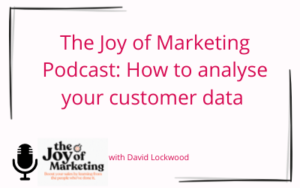Many retailers saw a spike in sales during the lockdowns, with new customers and high response rates. But as consumers started to return to physical stores, this left a wave of lapsing customers to re-engage with. Therefore, given the unprecedented events of the last 18 months, it’s especially important for retailers to consider the context of the economic environment as they start to plan their customer retention activities.
In our latest Retail Leaders Forum, David shone a light on customer retention in 2021. He talked to retail leaders about their plans to prevent customers from lapsing, engender loyalty, and ensure that retention marketing is operating at its fullest. Here are our top takeaways from the day.
Introduce micro-segmentation
During the pandemic, the percentage of purchases conducted online soared from around 18% to 36%. This has now settled down to around 27%, but remains higher than the 2019 level due to the change in buying habits. Offline marketing saw a similar pattern in response rates, peaking during 2020, then coming to rest at a greater level than it was pre-Covid.
If you have customers who purchased a lot during lockdown, they are likely now part of your ‘best’ customer group. But as physical retail re-emerged, these consumers may have started behaving differently from your conventional ‘best’ customers. Therefore, targeting these different groups as a whole may reduce marketing ROI.
Since we still face an uncertain retail environment in 2021, standard customer segmentation may not cut it either. Micro-segmentation is the identification of small clusters of customers who are behaving in different ways. Rather than simply grouping all your top customers into one segment, try to identify the micro-segments within it. Consider factors such as how those consumers rose to become top customers, and how quickly. This will enable you to more easily identify shifts in behaviour due to market changes.
Other important factors include channel usage and product mix, which may have changed temporarily during the 18 months. For example, targeting based only on recent purchase history can overlook those products which were popular pre-lockdown and which are now making a comeback. Consider how these factors may now change.
Improve personalisation and relevance
Personalisation and relevance play important roles in customer retention methods. Many marketers are still using a scattergun approach to emails, with a single email being sent to the whole customer base containing a wide variety of news or offers. Often, the content is not relevant to large groups of customers, which means they may not engage with it, or worse, start to switch off from the brand.
However, moving from a single ‘spray and pray’ email to a systematically relevant programme doesn’t need to be done in one go. It can be built piecemeal. For example, you could start by identifying a single category of buyers, and send them a different message from everyone else for three weeks. You can then measure if they spend more during that month. This only involves creating three more emails than usual, but if it produces a significant ROI, you could add more buyer categories, and bring in resource to produce the extra email creatives.
Automate communications where possible
In addition to a common body of text or graphics, emails can contain content blocks which are automatically populated based on the consumer segment. Providing the content blocks are formatted correctly, they can pull in relevant products or copy based on the customer’s purchase history, such as summer accessories for someone who regularly buys summer shirts.
Many ecommerce websites already use various triggers to send emails, such as abandoned baskets or browsing sessions. But there are other triggers which can effectively harness data. For example, you could celebrate customer birthdays and purchase anniversaries. These generate loyalty and repeat business because recipients feel more appreciated and less like an unknown statistic.
And this type of targeting can be taken further. Since customers accept that you hold data on their orders, you could use this specific information to highlight relevant products. For example, you could point out that as a customer has purchased a number of skirts from you in the past, they may want to check out your new skirt range.
In part two, we’ll look at how to better understand your customer base, and alternative incentives to discounts. If you’re looking for new ways to keep your customer engaged, talk to our team today.




